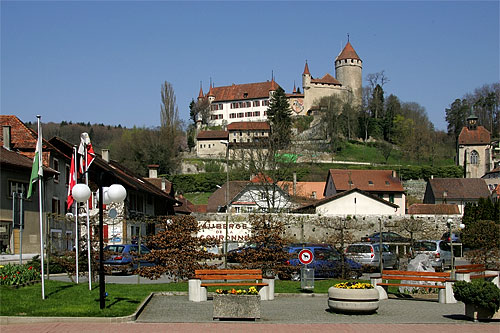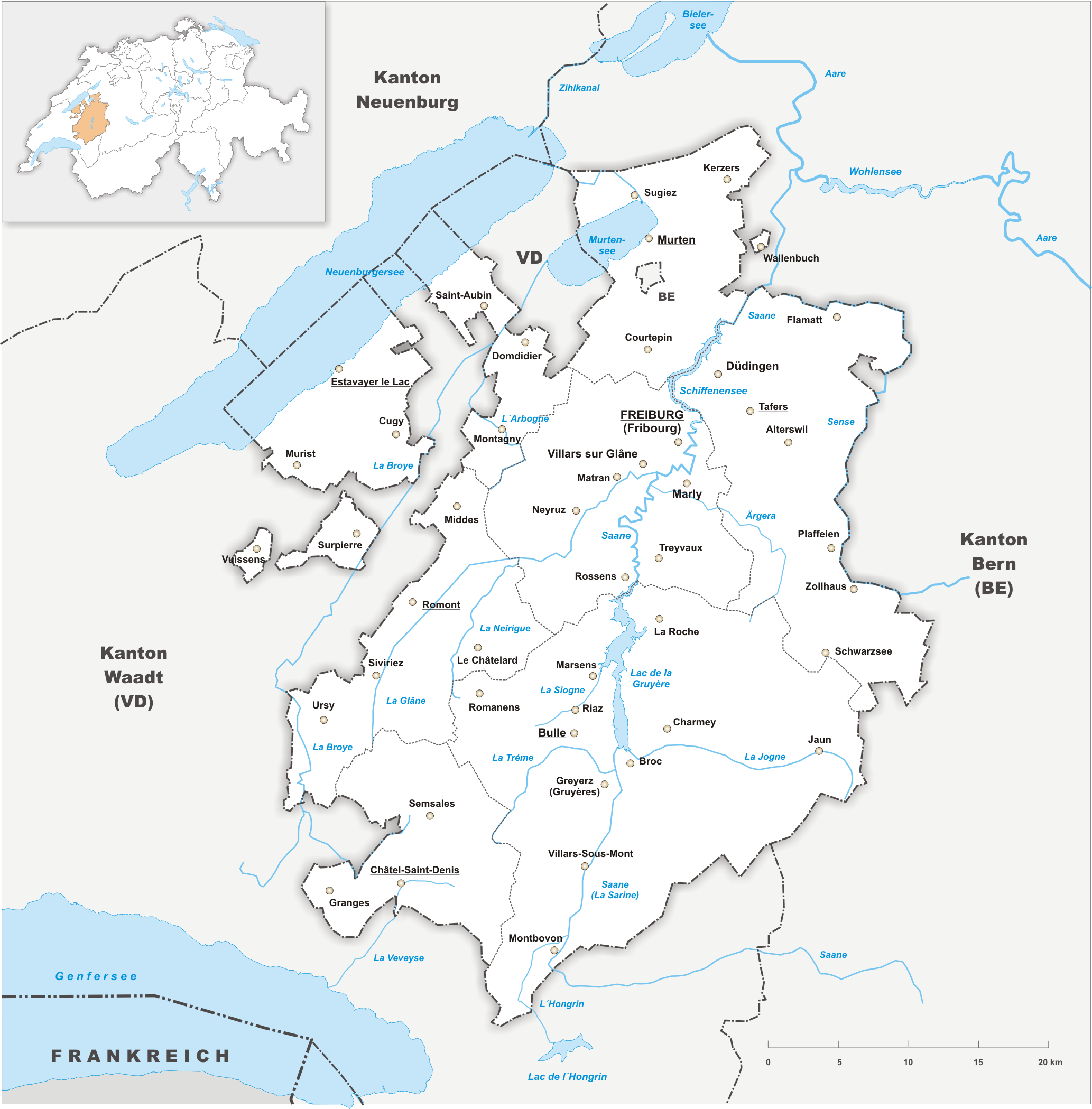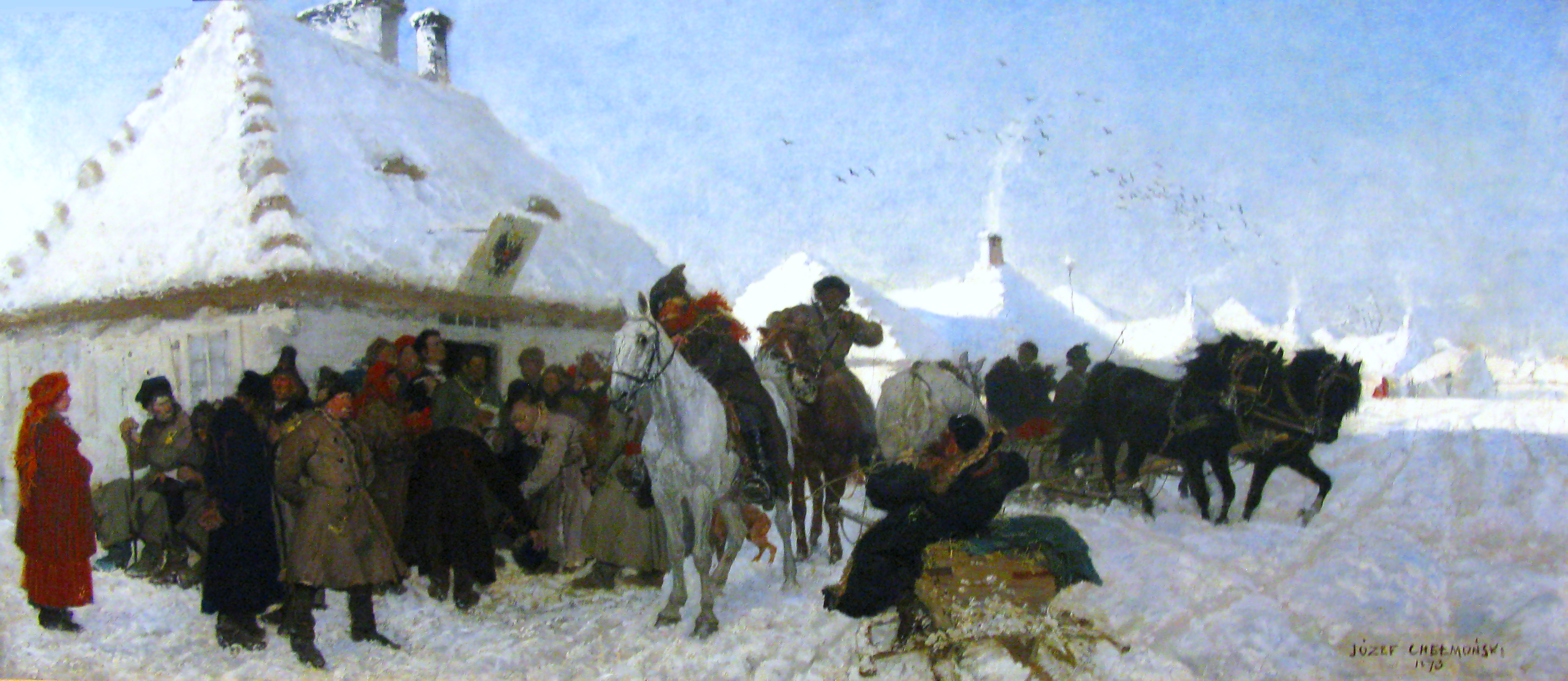|
Lucens Castle
Lucens Castle is a castle in the municipality of Lucens in the canton of Vaud in Switzerland. It is a Swiss heritage site of national significance. History The castle's strategic location allowed it to control the Broye valley, which was an important transit corridor. Starting in the Middle Ages and until 1536 it was a residence of the Bishop of Lausanne and served to control the Bishop's land in the Broye valley. During the 12th Century, the castle was repeatedly destroyed and rebuilt. In 1476, it was destroyed by the Swiss Confederation. In 1536 the valley and the surrounding territory were conquered by Bern. It became the seat of a Bernese bailiwick at the same time. In 1542, the vogt of Moudon moved into the castle. It was enlarged between 1579–86 and served as an arsenal and fortress on the border to Fribourg. In 1798, the Bernese were forced out and the Canton of Léman was formed. Shortly thereafter, the castle became the property of Canton, who sold it 1801 ... [...More Info...] [...Related Items...] OR: [Wikipedia] [Google] [Baidu] |
Lucens
Lucens () is a municipality in the Broye-Vully district in the canton of Vaud in Switzerland. In 2017 the former municipalities of Brenles, Chesalles-sur-Moudon, Cremin, Forel-sur-Lucens and Sarzens merged into the municipality of Lucens. History Lucens is first mentioned in 964 as ''in villa Losingus''. It was formerly known by the German name ''Losingen''. In 1969 the Lucens reactor, an underground nuclear reactor, began operations. It was a pilot project to test a heavy-water moderated, carbon dioxide gas-cooled reactor. Soon after the initial start up, an undetected blockage in one of the cooling pipes led to a partial fuel meltdown and massive radioactive contamination of the underground site. Following the accident, the reactor was decommissioned and the cavern was then sealed. No humans were irradiated in the accident. Geography After the 2017 merger Lucens had an area of . Before the merger Lucens had an area, (as of the 2004/09 survey) of . Of this ... [...More Info...] [...Related Items...] OR: [Wikipedia] [Google] [Baidu] |
Bern
Bern () or Berne; in other Swiss languages, gsw, Bärn ; frp, Bèrna ; it, Berna ; rm, Berna is the ''de facto'' capital of Switzerland, referred to as the " federal city" (in german: Bundesstadt, link=no, french: ville fédérale, link=no, it, città federale, link=no, and rm, citad federala, link=no). According to the Swiss constitution, the Swiss Confederation intentionally has no "capital", but Bern has governmental institutions such as the Federal Assembly and Federal Council. However, the Federal Supreme Court is in Lausanne, the Federal Criminal Court is in Bellinzona and the Federal Administrative Court and the Federal Patent Court are in St. Gallen, exemplifying the federal nature of the Confederation. With a population of about 133,000 (as of 2022), Bern is the fifth-most populous city in Switzerland, behind Zurich, Geneva, Basel and Lausanne. The Bern agglomeration, which includes 36 municipalities, had a population of 406,900 in 2014. The metropolitan ... [...More Info...] [...Related Items...] OR: [Wikipedia] [Google] [Baidu] |
Château
A château (; plural: châteaux) is a manor house or residence of the lord of the manor, or a fine country house of nobility or gentry, with or without fortifications, originally, and still most frequently, in French-speaking regions. Nowadays a ''château'' may be any stately residence built in a French style; the term is additionally often used for a winegrower's estate, especially in the Bordeaux region of France. Definition The word château is a French word that has entered the English language, where its meaning is more specific than it is in French. The French word ''château'' denotes buildings as diverse as a medieval fortress, a Renaissance palace and a fine 19th-century country house. Care should therefore be taken when translating the French word ''château'' into English, noting the nature of the building in question. Most French châteaux are "palaces" or fine "country houses" rather than "castles", and for these, the word "château" is appropriate in Eng ... [...More Info...] [...Related Items...] OR: [Wikipedia] [Google] [Baidu] |
List Of Castles In Switzerland
This list includes castles and fortresses in Switzerland. Entries list the name and location of the castle, fortress or ruins in each Canton in Switzerland. Aargau Appenzell Ausserrhoden Appenzell Innerrhoden Basel-Landschaft, Basel-Land Basel-Stadt Canton of Bern, Bern Canton of Fribourg, Fribourg Canton of Geneva, Geneva Canton of Glarus, Glarus Graubünden, Graubünden (Grisons) Canton of Jura, Jura Canton of Lucerne, Lucerne Canton of Neuchâtel, Neuchâtel Nidwalden Obwalden Canton of Schaffhausen, Schaffhausen Canton of Schwyz, Schwyz Canton of Solothurn, Solothurn Canton of St. Gallen, St. Gallen Ticino Thurgau Canton of Uri, Uri Vaud Valais Canton of Zug, Zug # Buonas Castle, Risch # Freudenberg Castle (Rotkreuz), Freudenberg Castle, Risch-Rotkreuz # Hünenberg Castle, Hünenberg # St. Andreas Castle, Cham, Switzerland, ... [...More Info...] [...Related Items...] OR: [Wikipedia] [Google] [Baidu] |
Safe Schools Declaration
The Safe Schools Declaration is an inter-governmental political commitment that was opened for endorsement by countries at an international conference held in Oslo, Norway, on 28–29 May 2015. The Declaration provides countries the opportunity to express political support for the protection of students, teachers, and schools during times of armed conflict; the importance of the continuation of education during armed conflict; and the implementation of the ''Guidelines for Protecting Schools and Universities from Military Use during Armed Conflict''. As of May 2023, 118 states have endorsed the Safe Schools Declaration, which remains open for additional countries to join. The Ministry of Foreign Affairs of Norway is the depositary of endorsements. On March 28–29, 2017, the ministries of foreign affairs and defense of Argentina co-hosted the Second International Safe Schools Conference in Buenos Aires. In May 2017, the United Nations Secretary General, António Guterres, urge ... [...More Info...] [...Related Items...] OR: [Wikipedia] [Google] [Baidu] |
Swiss Reformed Church
The Protestant Church in Switzerland (PCS), (EKS); french: Église évangélique réformée de Suisse (EERS); it, Chiesa evangelica riformata in Svizzera (CERiS); rm, Baselgia evangelica refurmada da la Svizra (BRRS) formerly named Federation of Swiss Protestant Churches (SEK); french: Fédération des Eglises protestantes de Suisse (FEPS); it, Federazione delle Chiese evangeliche della Svizzera; rm, Federaziun da las baselgias evangelicas da la Svizra until 31 December 2019, is a federation of 25 member churches – 24 Landeskirche, cantonal churches and the Evangelical-Methodist Church of Switzerland. The PCS is not a church in a theological understanding, because every member is independent with their own theological and formal organisation. It serves as a legal umbrella before the federal government and represents the church in international relations. Except for the Evangelical-Methodist Church, which covers all of Switzerland, the member churches are restricted to a cert ... [...More Info...] [...Related Items...] OR: [Wikipedia] [Google] [Baidu] |
Canton Of Léman
Léman was the name of a canton of the Helvetic Republic from 1798 to 1803, corresponding to the territory of modern Vaud. A former subject territory of Bern, Vaud had been independent for only four months in 1798 as the Lemanic Republic before it was incorporated into the centralist Helvetic Republic. Léman comprised all of the territory of Vaud detached from Bernese occupation, apart from the Avenches and the Payerne which, after 16 October 1802, were annexed by the canton of Fribourg until the Napoleonic Act of Mediation the following year when they were restored to the newly established and newly sovereign canton of Vaud. The capital of the canton was Lausanne, with the '' préfet''’s residence, the administrative chamber, and the judicial tribunal. The canton was divided into 17 administrative districts, each with a ''sous-préfet''. Léman was also one of the five cantons — purely administrative subdivisions — of the Rhodanic Republic planned in March 1798 by the Fr ... [...More Info...] [...Related Items...] OR: [Wikipedia] [Google] [Baidu] |
Canton Of Fribourg
The canton of Fribourg, also canton of Freiburg (french: Canton de Fribourg ; german: Kanton Freiburg ; frp, Canton de Fribôrg rm, Chantun Friburg it, Canton Friburgo) is located in western Switzerland. The canton is bilingual, with French spoken by more than two thirds of the citizens and German by a little more than a quarter. Both are official languages in the canton. The canton takes its name from its capital city of Fribourg. History On the shores of Lake Neuchâtel and Lake Morat significant traces of prehistoric settlements have been unearthed. The canton of Fribourg joined the Swiss Confederation in 1481. The area is made up of lands acquired by the capital Fribourg. The present extent was reached in 1803 when Murten (Morat) was acquired. The canton of Fribourg joined the separatist league of Catholic cantons in 1846 ( Sonderbund). The following year, its troops surrendered to the federal army. Geography The canton is bounded to the west by Lake Neuchâtel, to ... [...More Info...] [...Related Items...] OR: [Wikipedia] [Google] [Baidu] |
Vogt
During the Middle Ages, an (sometimes given as modern English: advocate; German: ; French: ) was an office-holder who was legally delegated to perform some of the secular responsibilities of a major feudal lord, or for an institution such as an abbey. Many such positions developed, especially in the Holy Roman Empire. Typically, these evolved to include responsibility for aspects of the daily management of agricultural lands, villages and cities. In some regions, advocates were governors of large provinces, sometimes distinguished by terms such as (in German). While the term was eventually used to refer to many types of governorship and advocacy, one of the earliest and most important types of was the church advocate (). These were originally lay lords, who not only helped defend religious institutions in the secular world, but were also responsible for exercising lordly responsibilities within the church's lands, such as the handling of legal cases which might require the u ... [...More Info...] [...Related Items...] OR: [Wikipedia] [Google] [Baidu] |
Bailiwick
A bailiwick () is usually the area of jurisdiction of a bailiff, and once also applied to territories in which a privately appointed bailiff exercised the sheriff's functions under a royal or imperial writ. The bailiwick is probably modelled on the administrative organization which was attempted for a very small time in Sicily and has its roots in the official state of the Hohenstaufen. In English, the original French ''bailie'' combined with '-wic', the Anglo-Saxon suffix (meaning a village) to produce a term meaning literally 'bailiff's village'—the original geographic scope of a bailiwick. In the 19th century, it was absorbed into American English as a metaphor for a sphere of knowledge or activity. The term survives in administrative usage in the British Crown Dependencies of the Channel Islands, which are grouped for administrative purposes into two bailiwicks — the Bailiwick of Jersey (comprising the island of Jersey and uninhabited islets such as the Minquiers ... [...More Info...] [...Related Items...] OR: [Wikipedia] [Google] [Baidu] |
Old Swiss Confederacy
The Old Swiss Confederacy or Swiss Confederacy ( Modern German: ; historically , after the Reformation also , "Confederation of the Swiss") was a loose confederation of independent small states (, German or In the charters of the 14th century described as "communities" (, ), the German term ''Orte'' becomes common in the early 15th century, used alongside "estate" after the Reformation. The French term is used in Fribourg in 1475, and after 1490 is increasingly used in French and Italian documents. It only enters occasional German usage after 1648, and only gains official status as synonym of with the Act of Mediation of 1803. ), initially within the Holy Roman Empire. It is the precursor of the modern state of Switzerland. It formed during the 14th century, from a nucleus in what is now Central Switzerland, expanding to include the cities of Zürich and Bern by the middle of the century. This formed a rare union of rural and urban communes, all of which enjoyed imp ... [...More Info...] [...Related Items...] OR: [Wikipedia] [Google] [Baidu] |







